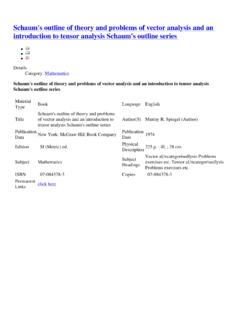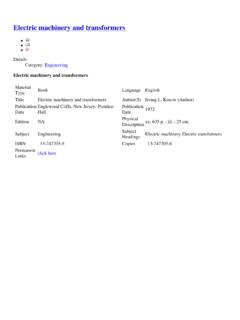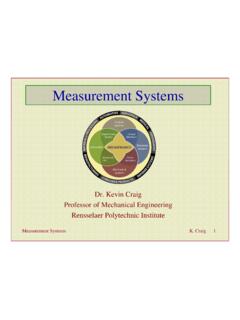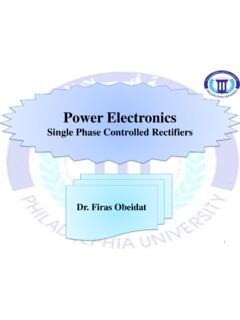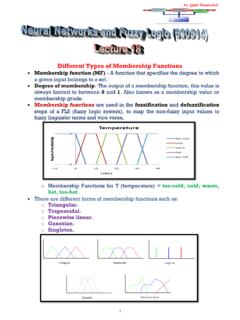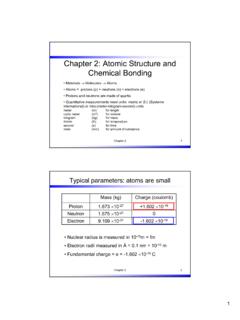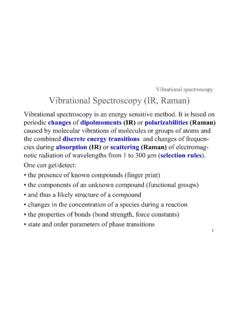Transcription of Basic Principles of Atomic Absorption and Atomic Emission ...
1 1 Basic Principles of Atomic Absorption and Atomic Emission Spectroscopy 2 Source Wavelength Selector Sample Detector Signal Processor Readout P Flame Atomic Emission Spectrometer 3 Flame Atomic Emission Spectrometer 4 Emission Techniques Type Method of Atomization Radiation Source Arc sample heated in an sample electric arc (4000-5000oC) Spark sample excited in a sample high voltage spark Flame sample solution sample aspirated into a flame (1700 3200 oC) Argon sample heated in an sample plasma argon plasma (4000-6000oC) 5 Flame and Plasma Emission Spectroscopy are based upon those particles that are electronically excited in the medium.
2 The Functions of Flame and Plasma convert the constituents of liquid sample into the vapor state. 2. To decompose the constituents into atoms or simple molecules: M+ + e- (from flame) -> M + hn 3. To electronically excite a fraction of the resulting Atomic or molecular species M -> M* Emission Spectroscopy 6 Measure the intensity of emitted radiation Emission Spectroscopy Gro und StateExc ited StateEmits Special Electromagnetic Radiation7 8 Argon Inductively Coupled Plasma as an atomization source for Emission spectroscopy 9 10 Flame techniques are limited to alkali (Li, Na, K, Cs, Rb) and some alkaline earth metals (Ca and Mg)
3 More energetic sources are used for more elements specially transition elements simultaneous multielement analysis since spectra od dozen of elements can be recorded simultaneously Interelement interference is eliminated Liquids and solids Why plasma source or other high energetic sources? 11 Advantages and disadvantages of Emission spectrometry Advantages rapid Multielement (limited for alkali and some alkaline earth metals ICP-AES has become the technique of choice for metals analysis. Disadvantages initial cost of ICP instrumentation continuing cost of operation (Ar required) 12 Flame Atomic Absorption Spectrometer Source Wavelength Selector Sample Detector Signal Processor Readout P Po Chopper 13 Flame Atomic Absorption Spectrometer T 14 Atomization Techniques Type Method of Atomization Radiation Source Atomic sample solution aspirated HCL (flame) into a flame Atomic sample solution evaporated HCL (nonflame) & ignited (2000 - 3000 oC))
4 (Electrothermal) Hydride Vapor hydride generated HCL generation Cold vapor Cold vapor generated (Hg) HCL 15 Advantages and disadvantages of Atomic Absorption Advantages sensitive (GFAA) selective Disadvantages intended for metallic/metalloid Atomic species, not nonmetals or intact molecular species lamps - one element at a time not easy for solids calibration curves nonlinear above A = more costly and less widely applicable than UV vis matrix effects - easy for some metals to be masked 16 17 Flame Fluorescence Spectrometer Source Wavelength Selector Sample Detector Signal Processor Readout P Po 90o 18 Fluorescence Techniques Type Method of Atomization Radiation Source Atomic sample soln.
5 Aspirated sample (flame) into a flame Atomic sample soln. evaporated sample (nonflame) & ignited x-ray none required sample fluoresence 19 Processes that take place in flame or plasma T 1 20 Flames Regions in Flame Temperature Profile 21 22 23 24 25 26 27 Flameless atomization Electrothermal atomization Graphite furnace atomization 28 29 30 31 Why do we use a temperature program in flameless AA? 32 Why do we use an inert gas with Flameless atomization? 33 Light source used for AA What light source do we use with AA?
6 Would it be a continuous light source or a line light source? A line light source is used for AA 34 T 2 35 36 How does the line source provide a single wavelenght? T3 37 38 39 AA spectrophotometer 40 41 42 43 44 Flame Emission -> it measures the radiation emitted by the excited atoms that is related to concentration. Atomic Absorption -> it measures the radiation absorbed by the unexcited atoms that are determined.
7 Atomic Absorption depends only upon the number of unexcited atoms, the Absorption intensity is not directly affected by the temperature of the flame. The flame Emission intensity in contrast, being dependent upon the number of excited atoms, is greatly influenced by temperature variations. Relationship Between Atomic Absorption and Flame Emission Spectroscopy 45 Measured signal and analytical concentration Emission Signal = Intensity of Emission = KNf = K Na =K C Nf = number of free atoms in flame Na = number of absorbing atoms in flame C = concentration of analyte in the sample K, K` and K depend upon.
8 Rate of aspiration (nebulizer) Efficiency of aspiration (evaporation efficiency) Flow rate of solution Solution concentration Flow rate of unburnt gas into flame Efficiency of atomization (effect of chemical environment). This depends upon Droplet size Sample flow rate Refractory oxide formation Ratio of fuel/oxygen in flame Temperature effect (choice of flame temperature) 46 2. Atomic Absorption Signal = I absorbed = Absorbance = A = k l C For the measurement to be reliable k must be constant; k should not change when a change in matrix or flame type takes place.
9 K depends upon same factors as those for the Atomic Emission spectroscopy 47 Background and Background Correction 48 Definition Sources of Background Background correction: Blank correction method Two-line correction method Continuous source correction method Zeeman effect correction method 49 What is a background? It is the signal observed when the element sought is absent The light at a specific wavelength (Analyte wavelength) is attenuated by the effect of flame components or matrix components in the sample Thus measured absorbance and analyte concentrations are too high If problem from flame, blank aspiration will correct for it It is more serious at short wavelengths (< 430 nm) and with graphite furnace 50 Sources of Background in Atomic Absorption 1.
10 Absorption by flame itself (Serious at below 220 nm; , As, Se, Zn ) Water blank can compensate for this flame Absorption In flame Absorption , background interference is insignificant at > 230 nm 51 2. Absorption by concomitant molecular species originating from the matrix like NaX or solvents containing X (halogen) like CCl4. Halides absorb at < 300 nm 3. Scattering of radiation from the particulate material in the flame Particulate material: Unevaporated droplets; unevaporated refractory salt particles Scattering is more serious at short 2 and 3 are most common with electrothermal atomizer 52 Specific Applications Require background correction 1.

